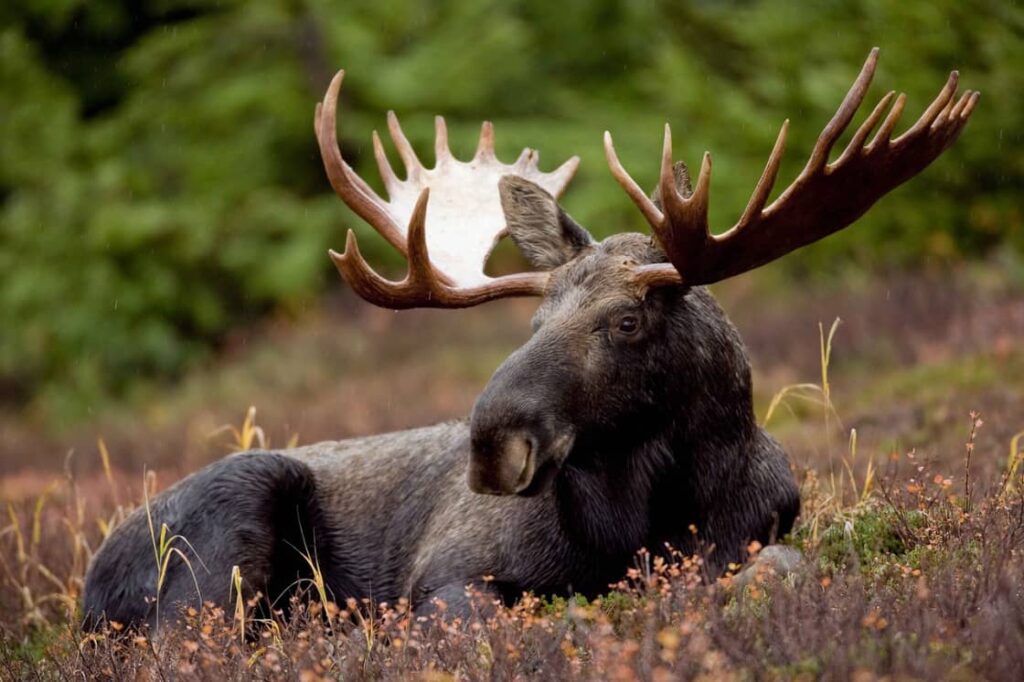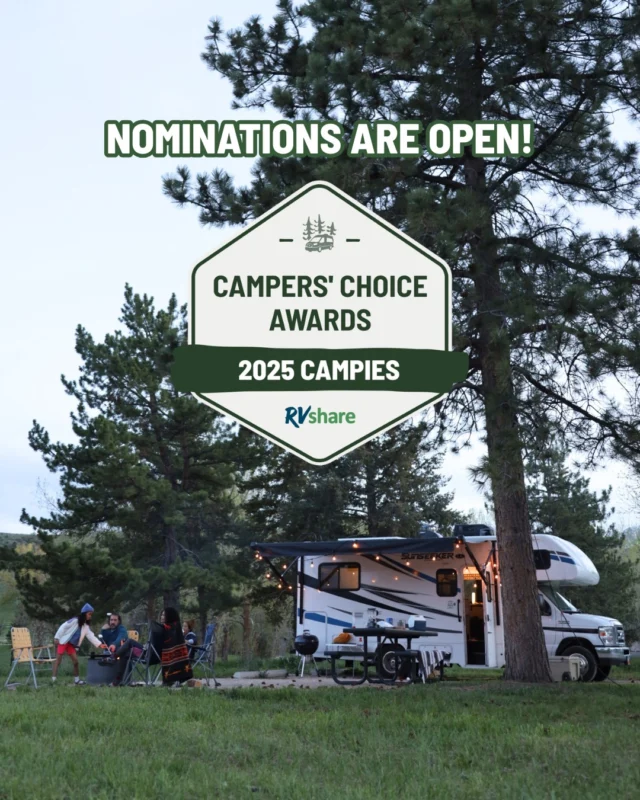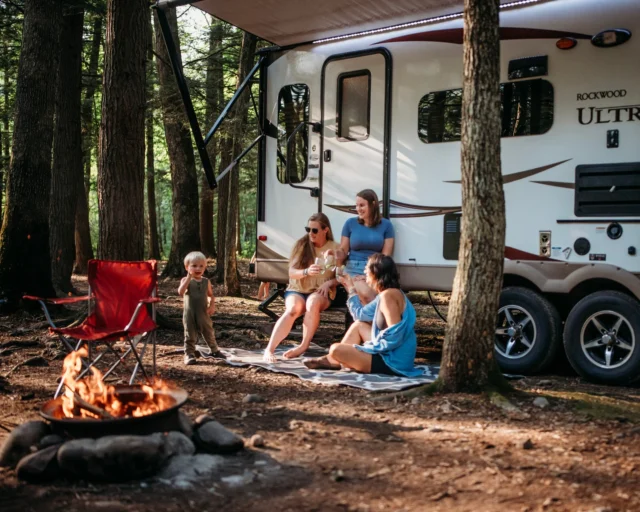
Moose live mostly in the northern regions of North America. They prefer colder climates and forest areas with streams, lakes, and ponds where they can find food and cool off. They are widespread throughout most of Canada, Alaska, New England, the Rocky Mountains, and the Pacific Northwest.
There are many popular RV destinations that are great places to see moose. National parks in mountain regions, such as those in Alaska, Washington, Colorado, and Michigan make scenic camping destinations and also have thriving moose populations. Watch for them as you drive and hike through wilderness areas.
If you’re in areas known to have moose and you see a number of people pulled over to the side of the road, it’s often a good bet to pull over as well. They may be watching moose or other wildlife. In fact, it can be easier to watch for crowds, rather than keeping your eyes peeled for moose themselves!
And while it’s true that moose are goofy-looking animals, they can be seriously dangerous when they feel threatened. Male moose can weigh up to 1,800 pounds and stand up to 7 feet tall at the shoulder. They can also run up to 35 mph in short bursts.
Moose attacks are rare, but they have been known to charge, kick, or stomp humans at times. They’re most aggressive during mating season and calving season when mothers are protecting their young. They also don’t like dogs, and view them as predators like wolves.
When you’re watching for moose, be sure not to get too close. A good rule of thumb is to use your actual thumb. Extend your arm in front of you with your thumb up. If you can see any part of the moose around your thumb, you’re too close. Use binoculars or a telephoto lens to get a better view of the moose. Never try to feed moose, and keep dogs leashed and under control to keep them from provoking these wild animals.
Here are several places in the U.S. that have high moose populations, and where you have a good chance of seeing one yourself.
Rocky Mountain National Park, Colorado
Rocky Mountain National Park has moose, elk, bears, bighorn sheep, mountain lions, and smaller mammals like yellow-bellied marmots and pikas. The park has two sides from which to enter – the east side near Estes Park and the west side near Grand Lake. Both sides have areas where moose like to congregate.
Also, moose don’t care about park boundaries – begin to keep your eyes peeled as you make your way to the park. And I once saw a moose laying down directly in front of the “Rocky Mountain National Park” sign at the entrance…almost as if he were being paid to pose there.
Best Moose Viewing Areas
The Kawuneeche Valley near the western entrance is a beautiful area with a variety of hikes. The Coyote Valley Trail is an easy, kid-friendly trail that is paved for strollers and wheelchairs. You get sweeping views of the valley and the start of the Colorado River. There are also lots of animals that visit this area, so it’s a good spot to watch for moose, elk, and other creatures. The Holzwarth Historic Site is a fun spot for families, and kids can learn about what life was like for the people who lived and vacationed here 100 years ago.
You can also look for moose all along the Colorado River, which runs through the western part of the park. Of course, they need water to drink, and it provides nutrient-rich plants for them to eat. But moose can also overheat at pretty low temperatures, so rivers and lakes provide great places for them to cool off.
Sprague Lake is on the eastern side of Rocky Mountain National Park. It’s another popular spot for moose, and I once saw a mother moose and her two calves standing in the water on a summer day. If you don’t see moose right in the lake, look for them in the nearby forests around the lake.
Nearby RV Campgrounds
Timber Creek Campground is on the west side of the park, about eight miles from Grand Lake. It’s open during the summer, usually from May to October. The campground is first-come, first-served. There are no hookups, but there is a seasonal dump station. Grand Lake/Rocky Mountain National Park KOA, formerly known as Elk Creek Campground, is outside the park, on the western side in Grand Lake. It has full hookups, laundry, showers, a dog park, and a pond for fishing.
Other Outdoor Activities
There are tons of hikes at Rocky Mountain National Park, ranging from easy and kid-friendly to extremely challenging. The hike to Alberta Falls from either the Glacier Gorge or Bear Lake Trailhead is a pretty one and this is one of the most-visited areas of the park. It’s about a 1.6-mile round-trip hike, with just 160 feet of elevation gain.
You can also spend a day fishing at many different points in the Colorado River. If you’re new to the area, or want to try fly fishing for the first time, consider hiring a guide from one of the many outfitters near the park. They’ll take you into RMNP, find great spots to fish, and give you tips on how to land a big one.
Also, be sure to take the Trail Ride Road drive from the western side of the park to the eastern side. The road is generally open from around Memorial Day through October, but the exact opening and closing days change depending on the weather. Be ready to stop at the many pullouts and overlooks along the drive for amazing views and possibly for wildlife as well. There is also a Visitor Center and restaurant at the summit. You’ll want to stop and learn more about the alpine areas of the park here. You can also take a short, steep trail up a little higher for more great views and possibly some sightings of yellow-bellied marmots and other wildlife. Listen for the marmots’ distinctive whistling noises that earned them the nickname “whistle pig” and watch them frolic in the alpine tundra.
Grand Teton National Park, Wyoming
Grand Teton National Park is known for its sweeping mountain views, sparkling lakes, and variety of wildlife. The park is also home to quite a few moose, and this is one of the best places in the country to see moose in their natural habitat. Here are some tips for spotting them.
Best Moose Viewing Areas
There are three popular areas to view moose at Grand Teton.
Moose-Wilson Road is a narrow drive that passes marshes, beaver ponds, and underbrush – all areas full of tasty moose food and where they love to hang out. Concentrate especially on the areas near the beaver ponds, as those are a favorite of theirs.
Oxbow Bend is along the Snake River, where the banks are full of willows – another favorite moose food. Watch for them among the trees, and keep your eyes peeled for other wildlife including otters, bald eagles, and trumpeter swans.
Gros Ventre River is east of Highway 89. Near the river, there are open flats and willow-lined riverbanks where the moose like to congregate and eat.
Nearby RV Campgrounds
Colter Bay RV Park is next to Jackson Lake inside the park. It has full hookups, laundry facilities, showers, restaurants, and a grocery store. You’ll also find a marina for boating on the lake, plus a gift shop, a visitor center, and horse corrals where you can book a ride. This campground is reservation-only, and reservations fill up quickly.
Gros Ventre Campground is the largest campground in the park, and the closest to the town of Jackson. It’s shaded by cottonwood trees and is within walking distance of the Gros Ventre River. There are electric hookups, a dump station, and ice and firewood for sale. The campground is open from May through October. This is a great campground for moose sightings nearby.
Other Outdoor Activities
There are lots of activities to do at Grand Teton. There are more than 250 miles of trails to hike in the park so you can find one for any skill level. The Cascade Canyon Trail is an especially scenic and popular hike, with waterfalls and mountain views. It’s a 13.6-mile hike with 1,300 feet of elevation gain. You can cut four miles of that distance by taking the shuttle boat across Jenny Lake. There is also the option to hike to Hidden Falls – about a mile from the boat drop – if you want a shorter hike or a scenic detour.
You can also paddleboard or kayak on Jenny, String, Leigh, or Jackson Lake. There are lots of places to fish in the park, as well as biking trails and horseback rides. Keep your eyes peeled for wild animals and birds as well. Finally, be sure to spend a day exploring nearby Jackson Hole. You’ll find lots of options for outdoor activities like skiing and snowmobiling in winter, and fly fishing, hiking, rafting, and more during the summer. The town also has upscale shopping and lots of trendy dining spots to treat yourself after a day outdoors.
Baxter State Park, Maine
Baxter State Park in Maine has a large wilderness area, making it a good place to see moose. Your best chances of seeing them are at dawn and dusk each day, which is when they begin to get more active. They also tend to be more active in late spring and summer – from mid-May through July – and in the fall during mating season. Bull moose also have their antlers fully grown in the fall, making an impressive display.
Best Moose Viewing Areas
Moose tend to congregate in a few different areas of the park. Sandy Stream Pond and Stump Pond are two of the popular spots for both moose and moose-watchers. These areas can get crowded with people hoping to catch a glimpse of a moose, especially in peak seasons. The Golden Road is a 96-mile logging road that runs to the Canadian border. It’s a less-crowded spot to watch for moose if you want to escape the crowds of Sandy Stream Pond. Take a drive along Golden Road and watch for majestic moose.
Daicey Pond is another good spot to watch for moose, especially during the late afternoon and early evening. Watch for moose here from about 4:30-6p, as they get more active around twilight.
There are also several companies near the park that offer guided moose tours. These can be helpful because guides know where moose tend to hang out, and they know recent moose movements in the area.

Nearby RV Campgrounds
Wilderness Edge Campground in Millinocket is on the access road to Baxter State Park. It offers 50 Max AMP hookups and has a dump station along with a playground, laundry facilities, showers, a pool, and kayak rentals. Katahdin Shadows Campground in Medway has full hookups, a pool, and planned events for campers.
Other Outdoor Activities
There’s plenty to do at Baxter State Park besides watching for moose. If you’re up for a strenuous climb, you can hike Mount Katahdin. Trails to the top range from 4.4 miles one way to 5.2 miles one way. The elevation gain is considerable, however – you’ll be going up more than 4,000 feet from the bottom to the top. This isn’t a hike to tackle on a whim…you’ll want to have trained well before attempting it.
You can also paddle on the Penobscot River, and there are lots of places to fish in the park. Also, along with watching for moose, you can look for black bears, white-tailed deer, beavers, muskrats, foxes, weasels, and lots of other small mammals. The park is also ideal for birdwatching and park staff have recorded more than 178 species.
Denali National Park, Alaska
You can find moose in several Alaska national parks, but Denali National Park is a particularly good destination for moose-watching. Here are some tips for finding them at the park.
Best Moose Viewing Areas
You may see moose near the entrance to the park, especially in the springtime. They like the Riley Creek Campground for its tasty vegetation and forest areas. Horseshoe Lake is also near the entrance and is a popular hangout for moose. They like eating the trees and shrubs here, and in summer moose enjoy cooling off in lakes and streams even in Alaska! You might also spot moose at the Teklanika River. This area is known as a “wildlife superhighway” and attracts lots of animals including caribou, wolves, grizzlies, and more.
During the fall – moose rutting season – you may find them between miles 9 and 13 of the Denali Park Road. Look for bulls in open areas as they search for mates.
Nearby RV Campgrounds
Riley Creek Campground is inside Denali park boundaries. There are no hookups at this wooded campground, but it can accommodate both tent and RV camping. You’ll get cell phone reception at the campground, and there are seasonal amenities – a camp store, laundry facilities, showers, and a dump station. You can walk from the campground to the visitor center, and on to other trails in the park.
Denali RV Park & Motel is just outside the park. It has full hookups, laundry facilities, showers, gas grills, and a full-service tour and activity desk to help you plan your visit.
Other Outdoor Activities
There are several tour companies in the area that can take you on drives in the park. Many of these tour operators know where moose like to congregate, and can take you to those areas. They’ll also show you around other interesting areas in the park.
There are also several companies that do flightseeing tours of Denali. See the park from the air in a small plane. You’ll get interesting views of glaciers and mountains, and you can even spot mountain climbers as they make their way to the summits of mountains in the park.
There are lots of hiking trails in the park as well. The Savage River Loop Trail is an easier hike that’s suitable for all ages. It’s a 2-mile round trip that takes about an hour, and the hike is fairly flat as well. You’ll follow the Savage River through a canyon, and you’ll get beautiful views of rock formations and the glacier-fed river.
Isle Royale National Park, Michigan
Isle Royale National Park is one of the most remote national parks in the U.S. and is on an island in Lake Superior. Moose are believed to have arrived on the island either by swimming or crossing the ice in winter. Wildlife experts have studied the moose and wolves on the island for 60 years, trying to understand the predator-prey relationship between the species.
Best Moose Viewing Areas
Windigo is an area that’s well-known for moose sightings. It’s on the western end of the island near Washington Harbor. You might spot moose in the creek or near the mouth of the creek where it joins the harbor. Moose love the aquatic plants by the water, and they enjoy cooling off in the shady areas or in the water during the summer months.
You might also spot moose at Rock Harbor in the park, although they are less frequent here than they are at Windigo or other areas of the park. Sometimes, moose might venture near the Rock Harbor Lodge although they prefer areas with fewer people.
Moose sightings are also common along the Greenstone Ridge Trail, especially near forests and lakes. They enjoy the woods and wetlands and will graze in those areas of the trail.
You can also look for moose at Scoville Point, especially during the spring. You might spot cows with their calves, since this area provides shelter and food for them at this vulnerable time.
Nearby RV Campgrounds
There are no RV-accessible campgrounds in the park – all campers reach their campsites either on foot or via boat. There are several campgrounds and resorts on the mainland, however. You can take the ferry across to enjoy the island during the day, and return to your rig at night to sleep in comfort. Try either Copper Harbor or Houghton to find RV-friendly campgrounds.
Fort Wilkins Historic State Park is in Copper Harbor and has full hookups. There are laundry facilities, showers, and a playground for kids.
Other Outdoor Activities
There are lots of things to do at Isle Royale besides watching for moose. You can go backpacking while at the park, and some treks can last several days. There is also kayaking, canoeing, or paddleboarding in the many bodies of water at the park. You can even explore several shipwrecks while scuba diving at the park. And you can learn more about the wolf and moose research at the island’s visitor centers.
Yellowstone National Park, Wyoming/Montana/Idaho
Yellowstone National Park is primarily in Wyoming, but it stretches across three states in all. The park is teeming with wildlife – in fact, it has the largest concentration of mammals in the lower 48 states. Along with moose, you’ll find bison, elk, bears, loves, lynx, pronghorn antelope, and many more.
Best Moose Viewing Areas
Moose at Yellowstone like to hang out in Lamar Valley, which is sometimes called “The North American Serengeti” because of all the wildlife in the area. The eastern side near Soda Butte Creek and Pebble Creek are especially good places to watch for moose as there are lots of willows and shrubs for them to eat.
Willow Park, between Mammoth Hot Springs and Norris Junction, is another of the best areas in the park to view moose. The area has lots of willows, which are a favorite moose food.
Yellowstone Lake is another place where moose will gather, although it’s less popular than the above areas. But look for them around the lake, especially in the marshy areas or the willow thickets. The Fishing Bridge and Pelican Creek are both near the lake and are also places where you might find moose.
Nearby RV Campgrounds
Yellowstone has a number of campgrounds inside the park, but because this is one of the most popular parks in the country you’ll want to make reservations as soon as possible. Fishing Bridge RV Park is the only campground in the park that offers water, sewer, and electrical hookups. Grizzly bears are often in the area, so there are no tents or tent campers allowed at this campground.
Yellowstone Grizzly RV Park is in West Yellowstone, just three blocks from the park entrance. It has full hookups, showers, and a playground for kids.
Other Outdoor Activities
There are tons of other outdoor activities at Yellowstone besides moose-watching. Make sure to catch a geyser eruption at Old Faithful, see the multi-colored Grand Prismatic Spring, and admire the park’s other geothermal features. Watch for all kinds of wildlife in the Lamar Valley. Hike Fairy Falls Trail – a scenic hike to one of Yellowstone’s most spectacular waterfalls.
You can also go boating, horseback riding, fishing, and more during the summer. In winter, enjoy skiing, snowshoeing, and snowmobiling.
Best Time of Year to See Moose
It’s possible to see moose at any time of year, but you’ll find them in different places and doing different things, depending on the seasons.
When you are looking for moose, try to search at sunrise and sunset. These are the times moose tend to be most active during the day.
Spring
You can see moose in late spring – May and June – as they begin to enjoy snacking on budding leaves and shoots. This is also calving season, so you may see mothers venture out with their new spring calves. Look for moms and babies in marshy areas where they have plenty of foliage to eat. Male moose begin growing their antlers during spring, and those will continue to develop throughout the summer.
Summer
In mid-summer – July and August – you’ll often find moose in lakes and rivers, cooling off during the day. Moose have a low tolerance for heat, and they can spend long periods of time immersing themselves in cool water, even at higher elevations. They also enjoy eating the aquatic plants that are full of minerals and nutrients for them. Moose will graze heavily throughout the day, building up their fat stores for winter. They may be more active later in the day and early in the morning when it’s cooler out as well.
By the end of summer, male moose antlers have reached their full size, ready to attract the ladies in the fall.
Fall
September and October are moose mating season. Bulls are more active during the fall, and you may spot them out and about as they search for a mate. Bulls may also spar each other with their antlers during this season.
Winter
In the winter, moose move to lower elevations as they search for food. Moose are also easier to spot as they stand out against snowy landscapes. Their coats grow thicker to keep them warm, and they conserve energy by remaining more in one area, often with shelter and easily accessible food. They eat twigs, bark, and buds to sustain themselves through the winter.
Watching for moose can be a fun and rewarding experience, and can lead to some great photos and memories! Remember to give these majestic animals plenty of space, to keep pets leashed, and to avoid sudden noises or movements that could startle them.
If you hope to spend several days camping and moose-watching, consider renting an RV from RVshare. You can spend your days enjoying state and national parks and watching for wildlife, and retreat to a comfortable bed each evening! And if you want to watch for other wildlife, check out our guide to where to see wolves in the U.S.






